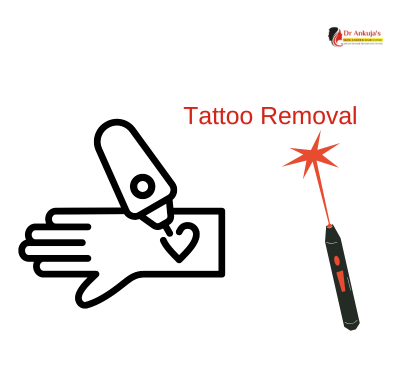Tattoos are a form of self-expression, but sometimes people outgrow them or wish to remove designs that no longer align with their lifestyle, career, or personal choices. In India, the demand for tattoo removal has grown significantly in recent years. With advanced technology, laser tattoo removal has become the most effective and safe method for getting rid of unwanted ink.
This blog will walk you through how laser tattoo removal works, what to expect during the procedure, possible side effects, aftercare tips, and answers to common questions. Whether you want a complete removal or just lightening for a cover-up tattoo, understanding the process can help you make an informed decision.
Why Do People Opt for Tattoo Removal?
Before diving into the technology, let’s look at the common reasons why people choose tattoo removal:
- Lifestyle or career changes – Certain professions may discourage visible tattoos.
- Personal transformation – A tattoo may no longer hold meaning after life changes.
- Poor tattoo quality – Bad design, spelling mistakes, or fading ink often lead to removal requests.
- Cover-up purposes – Sometimes, people want to lighten a tattoo to replace it with a new design.
- Medical reasons – Rare allergic reactions or skin issues may necessitate tattoo removal.
Understanding How Laser Tattoo Removal Works
Laser tattoo removal uses high-intensity light beams to break down tattoo ink particles in the skin. Here’s a step-by-step explanation:
- Laser Targeting – The laser emits pulses of light that specifically target tattoo ink without harming surrounding skin.
- Ink Breakdown – The energy from the laser shatters the ink into tiny fragments.
- Natural Elimination – Over the following weeks, the body’s immune system gradually clears away the ink fragments.
- Multiple Sessions – Since tattoos have multiple ink layers, complete removal typically requires several sessions spaced weeks apart.
Different laser wavelengths are used for different ink colors:
- Black and dark blue inks respond well to standard lasers.
- Green, yellow, and red inks are more challenging but can be treated with advanced Q-switched and picosecond lasers.
The Tattoo Removal Procedure: What to Expect
1. Consultation
Your dermatologist or skin specialist will assess:
- Tattoo size, location, and colors used.
- Your skin type and medical history.
- The estimated number of sessions needed.
2. Pre-Treatment Care
- Avoid sun exposure before treatment.
- Do not apply creams, makeup, or fake tan on the tattooed area.
- Shave the area if needed.
3. During the Session
- A cooling device or numbing cream may be applied for comfort.
- The laser is directed at the tattoo, producing quick pulses of light.
- Patients often describe the sensation as similar to a rubber band snapping against the skin.
- Small tattoos may take only a few minutes; larger ones may require more time.
4. After the Session
- The treated area may feel warm, swollen, or appear white immediately after.
- Ice packs and soothing ointments are usually recommended.
- A protective dressing may be applied.
Number of Sessions Required
The number of sessions varies depending on:
- Tattoo size – Larger tattoos require more sittings.
- Ink colors – Dark inks fade faster than light colors.
- Tattoo age – Older tattoos are easier to remove.
- Skin type – Melanin levels influence laser settings and results.
On average, 6–10 sessions may be required for significant fading, with each session spaced 6–8 weeks apart.
Side Effects and Risks
Laser tattoo removal is generally safe when done by trained professionals, but some side effects may occur:
- Temporary redness, swelling, or blistering.
- Mild pain or discomfort.
- Pigment changes (lightening or darkening of skin) in rare cases.
- Scarring is uncommon if aftercare is followed correctly.
Aftercare Tips for Faster Healing
Following proper aftercare ensures faster recovery and better results:
✅ Keep the treated area clean and dry.
✅ Apply prescribed ointments or soothing creams.
✅ Avoid scratching or picking scabs.
✅ Protect from direct sunlight by using sunscreen.
✅ Avoid hot showers, saunas, and swimming until healed.
Pros and Cons of Laser Tattoo Removal
| Pros | Cons |
| Safe and effective | Requires multiple sessions |
| Minimal risk of scarring | Slight discomfort during procedure |
| Works on most ink colors | Can be costly |
| Non-invasive | May cause temporary side effects |
Cost of Tattoo Removal in India
The cost varies depending on tattoo size, colors, and clinic location. On average:
- Small tattoos: ₹2,000–₹5,000 per session
- Medium tattoos: ₹5,000–₹10,000 per session
- Large tattoos: ₹10,000+ per session
Since multiple sessions are needed, the total cost may add up. However, for many, it is worth it to regain clear skin or prepare for a better tattoo.
Tattoo removal with laser technology has made it possible to safely erase unwanted ink without invasive surgery. While patience is required due to multiple sessions, the results can be life-changing. By following the right aftercare and consulting a qualified skin specialist, you can achieve clear, healthy skin once again.
FAQ
1. Is laser tattoo removal painful?
Most people describe it as mildly uncomfortable, similar to a rubber band snapping against the skin. Numbing creams or cooling devices help reduce discomfort.
2. Can all tattoo colors be removed completely?
Black and dark blue tattoos fade the fastest. Green, yellow, and red inks may require more advanced lasers and extra sessions. While complete removal is possible, some tattoos may only fade significantly.
3. Will my skin look normal after tattoo removal?
In most cases, the skin returns to its natural appearance after healing. Rarely, there may be slight pigment changes, but scarring is uncommon when done by a professional.

